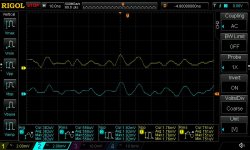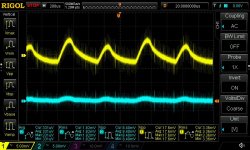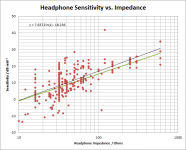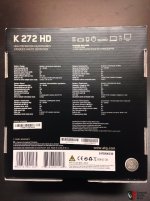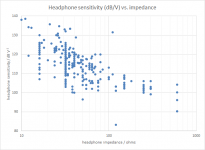The system gain should be set so the volume level is at 8 to 11 o'clock when for listening to common sources at a comfortable level.
25 dB is a good estimate for home hifi HD600 and AKG702 headphones. 15 dB is about right for most mid-range over-ear types, while most IEMs need less, perhaps 6 dB. Since there is considerable variation with input sources, there is no need to be more precise than this.
Once you know the right value for one set of headphones, it is easy to determine the right gain for any headphone knowing the sensitivity and impedance. That's how the BOM gain calculator works.
*****
It's pretty easy to calculate the output impedance of the Sapphire 4, since it is artificially restricted by R17,18. it's just 4.7/2+~1 ohms, so call it about 3-4 ohms in open loop, and much less closed loop.
25 dB is a good estimate for home hifi HD600 and AKG702 headphones. 15 dB is about right for most mid-range over-ear types, while most IEMs need less, perhaps 6 dB. Since there is considerable variation with input sources, there is no need to be more precise than this.
Once you know the right value for one set of headphones, it is easy to determine the right gain for any headphone knowing the sensitivity and impedance. That's how the BOM gain calculator works.
*****
It's pretty easy to calculate the output impedance of the Sapphire 4, since it is artificially restricted by R17,18. it's just 4.7/2+~1 ohms, so call it about 3-4 ohms in open loop, and much less closed loop.
Last edited:
There is excellent Headphone Power Calculator at this web page:
Headphones Power Calculator
that I found very usefull and handy to calculate power hunger of various headphones.
I thought it was neither useful nor excellent. It says nothing about how much voltage gain you need in your headphone amplifier, and it grossly overestimates the real-world design requirements of the output stage.
Pro Tip: you do not need to be able to reproduce a sine wave at 115 dB to be able to cleanly play music to "very loud" volumes.
One channel or both? This is important.
Yep, in both exactly the same.
Had tried a zobel filter, but no effect, the noise is not high frequency.
Thanks for the attention, I will continue to look for the problem.
Some assembly error or some bad component.
I just wonder why would someone want so much gain ?
I also believe that it is more than really necessary. But I will continue to look for the solution, because originally the problem does not happen, there is certainly something wrong here.
I thought it was neither useful nor excellent. It says nothing about how much voltage gain you need in your headphone amplifier, and it grossly overestimates the real-world design requirements of the output stage.
True. However, I found it useful because it gives you reference to listening loudness levels in dB SPL, and corresponding voltage, current and power required for a given headphones. These are absolute ratings, while voltage gain is relative to the source, and line out levels of different equipment out there varies from 0,7V to 2V RMS which would actually make a difference.
I'm well aware of the implication of voltage gain and amplifier limitation and besides testing with resistive load I would never try to set volumes as high to cause clipping. (that would be painful with headphone on)
Since I'm building amp for myself I think it is better to have the useful pot range that span more than up yo 8 to 11 o'clock. So I want to scale it so max volume is still safe and comfortable listening level is easily reachable.
PS: I tried to make my build with closed loop unstable and all combination from the excel are fine without zobel at the output.
@felipeunix
Sorry I can't be of more help, that output signal you posted is unlike anything I've seen before and I can't think of anything that could cause it.
@bczupa
Thanks for that. It fits with my own experience. Everything so far indicates it is extremely stable and well behaved. Which makes felipeunix's problem all the stranger.
As for volume level, I'm curious now to know how many people listen above 12 o'clock. I hate doing so. The control feel is less responsive, and the output impedance of the volume pot rises considerably. For me the ideal median listening position is 10 o'clock. In my experience most commercial preamps are set up more-or-less to this standard.
Sorry I can't be of more help, that output signal you posted is unlike anything I've seen before and I can't think of anything that could cause it.
@bczupa
PS: I tried to make my build with closed loop unstable and all combination from the excel are fine without zobel at the output.
Thanks for that. It fits with my own experience. Everything so far indicates it is extremely stable and well behaved. Which makes felipeunix's problem all the stranger.
As for volume level, I'm curious now to know how many people listen above 12 o'clock. I hate doing so. The control feel is less responsive, and the output impedance of the volume pot rises considerably. For me the ideal median listening position is 10 o'clock. In my experience most commercial preamps are set up more-or-less to this standard.
@felipeunix
Sorry I can't be of more help, that output signal you posted is unlike anything I've seen before and I can't think of anything that could cause it.
Very happy that I type this message.
I found the problem, I will not explain exactly where the problem was because it is an unusual situation.
But it was causing ground loop.
I tested it on all BOM settings, perfect!
The sound is great!
I kept the standard R3x = 2.2k R2 = 470R.
Many thanks for your attention, Richard.
Best Regards.
I just start listening the amp with another (closed) headphones: AKG K272HD
and noticed that your Excel is using dB/mW which is somehow depreciated now - for most new headphones sensitivity is given in dB/V now (wasn't paying attention to that before)
You might just want and a formula to your Excel to convert dB/V to dB/mW (for those who only have specs given in db/V like for these AKG)
=E5-30+10*LOG(E3)
where E5 is the place where sensitivity in dB/V was put
since:
dB/mW = dB/V - 30 + 10*log(R)
where
dB/mW is the sensitivity in dB (SPL) at 0.001 watt
dB/V is the sensitivity in dB (SPL) at 1 volt rms into impedance R and
R is the headphone nominal impedance in ohms.
Anyway, AKG K272HD are driven easily with gain 15bB , even though recommended gain is calculated as 38dB (55ohm 91dB/V = 78dB/mW )
I tried to measure if addition of zener reg is doing anything useful in terms of noise filtering, but couldn't see any real change under normal conditions (I hit the end of resolution of my cheap digital osciloscope - the input noise is already too low to be measured)
However, when amplifier is driven to its limits and starts clipping, the added zener regulator is acctually making things worse - not much Vpp=17mV but it can be noticed.
Ch1 is the output from the zener reg (transistor emiter)
CH2 is the output from the regulated power supply which is feed to transistor's
So I can safely say that using zener eg in my case is pointless as it cancel some advantages that liner regulators provides and gives nothing in return.
Besides the technical measurements which I do for fun only, the pleasure from listening the amp is enormous.
and noticed that your Excel is using dB/mW which is somehow depreciated now - for most new headphones sensitivity is given in dB/V now (wasn't paying attention to that before)
You might just want and a formula to your Excel to convert dB/V to dB/mW (for those who only have specs given in db/V like for these AKG)
=E5-30+10*LOG(E3)
where E5 is the place where sensitivity in dB/V was put
since:
dB/mW = dB/V - 30 + 10*log(R)
where
dB/mW is the sensitivity in dB (SPL) at 0.001 watt
dB/V is the sensitivity in dB (SPL) at 1 volt rms into impedance R and
R is the headphone nominal impedance in ohms.
Anyway, AKG K272HD are driven easily with gain 15bB , even though recommended gain is calculated as 38dB (55ohm 91dB/V = 78dB/mW )
I tried to measure if addition of zener reg is doing anything useful in terms of noise filtering, but couldn't see any real change under normal conditions (I hit the end of resolution of my cheap digital osciloscope - the input noise is already too low to be measured)
However, when amplifier is driven to its limits and starts clipping, the added zener regulator is acctually making things worse - not much Vpp=17mV but it can be noticed.
Ch1 is the output from the zener reg (transistor emiter)
CH2 is the output from the regulated power supply which is feed to transistor's
So I can safely say that using zener eg in my case is pointless as it cancel some advantages that liner regulators provides and gives nothing in return.
Besides the technical measurements which I do for fun only, the pleasure from listening the amp is enormous.
Attachments
According to the data I have, the AKGs are 55 ohms and 104 dB/V (91 dB/mW).
Still, let me take another look at the worksheet. It perhaps needs to be tweaked.
Your conclusion that the Z-Reg increases ripple at high output current makes sense when you think about it, as the output impedance o the Z-Reg is much higher than the regulated supply output and there is relatively small capacitance after the Z-Reg. Certainly, there is no reason to have the Z-Reg active when using a regulated power supply, though if it sounds better that way by all means keep them. An alternative as someone suggested a few posts back is to convert them to operate as capacitance multipliers.
P.S. Glad you are enjoying the amp. It's very nice feeling to know that people like it.
Still, let me take another look at the worksheet. It perhaps needs to be tweaked.
Your conclusion that the Z-Reg increases ripple at high output current makes sense when you think about it, as the output impedance o the Z-Reg is much higher than the regulated supply output and there is relatively small capacitance after the Z-Reg. Certainly, there is no reason to have the Z-Reg active when using a regulated power supply, though if it sounds better that way by all means keep them. An alternative as someone suggested a few posts back is to convert them to operate as capacitance multipliers.
P.S. Glad you are enjoying the amp. It's very nice feeling to know that people like it.
Attachments
Last edited:
So, revisiting the gain calculator I find - as so often happens - that the calculation was numerically correct but needlessly complicated.
If you have the sensitivity of your headphones in dB/V it's trivial, just subtract from 127:
recommended amplifier gain = 127 - [sensitivity in dB/V]
as bczupa notes above, the conversion from dB/mW to dB/V is
dB/mW = dB/V - 30 + 10*log(R)
so substitution gives
recommended amplifier gain = 97 - [sensitivity in dB/mW] + 10*log(headphone_Z)
This will only be useful to you if you agree with me that 25 dB is about the right gain setting for Sennheiser HD600. If you think that's 6 dB too high for example, reduce the recommended value by the same amount.
41m5 BOM attached with the new gain calculator which now accepts sensitivity input in either dB/W or dB/V.
If you have the sensitivity of your headphones in dB/V it's trivial, just subtract from 127:
recommended amplifier gain = 127 - [sensitivity in dB/V]
as bczupa notes above, the conversion from dB/mW to dB/V is
dB/mW = dB/V - 30 + 10*log(R)
so substitution gives
recommended amplifier gain = 97 - [sensitivity in dB/mW] + 10*log(headphone_Z)
This will only be useful to you if you agree with me that 25 dB is about the right gain setting for Sennheiser HD600. If you think that's 6 dB too high for example, reduce the recommended value by the same amount.
41m5 BOM attached with the new gain calculator which now accepts sensitivity input in either dB/W or dB/V.
Attachments
Last edited:
According to the data I have, the AKGs are 55 ohms and 104 dB/V (91 dB/mW).
There is a lot of confusion about the specification of these headphones. I would rather believe what is printed on the box and it is 91 dB SPL/V, but I agree that this is insanely low !
Other independent measurements seems to confirm that these are less sensitive than 91db SPL/mW:
https://www.innerfidelity.com/images/AKGK272HD.pdf
and for comparison, measurment from the same soure for HD600:
https://www.innerfidelity.com/images/SennheiserHD600.pdf
and AKG K271 MK2 with know 91dB SPL/mW (104dB SPL/V)
https://www.innerfidelity.com/images/AKGK271MkII.pdf
power needed to reach 90db SPL: 0.35mW vs 0.17mW vs 0.14mW
Whatever it is, there is no problem driving them to the painfully loud loudness volume with pot on max 12 o'clock position.
Still, let me take another look at the worksheet. It perhaps needs to be tweaked.
Step by step and we will make documentation better
Attachments
The innerfidelity datasheets you kindly linked to allow us to resolve this easily:
HD600 102.7 dB/V 97.6 dB/mV [note measurements and Sennheiser stated values agree exactly within error] (recommended gain by my calculation 24 dB)
AKG 271 mk II 110.6 dB/V 98.4 dB/mV (recommended gain 16 dB)
AKG 272 HD 106.8 dB/V 94.6 dB/mV (recommended gain 20 dB)
So the values I had for the 272, 104/91 seem to be correct. The printed packaging material is in error.
And since it appears you like to have the volume position a little higher than me, 15 dB for the amp gain should be about right for you vs. my own estimate of 20 dB.
If you think about it, 91 dB/V is unrealistically low. In my database of 300+ models, only one headphone with impedance less than 100 ohms has a sensitivity less than 100 dB/V. (see attached chart)
[quick check: voltage for 90 dB is 0.24 V for the Sennheiser, 0.145 V for the 272. Right away you know that the AKG is *more* sensitive than the HD600, so will need *less* amp gain. It's a little less than a factor of two, so 4-5 dB more sensitive round numbers.]
HD600 102.7 dB/V 97.6 dB/mV [note measurements and Sennheiser stated values agree exactly within error] (recommended gain by my calculation 24 dB)
AKG 271 mk II 110.6 dB/V 98.4 dB/mV (recommended gain 16 dB)
AKG 272 HD 106.8 dB/V 94.6 dB/mV (recommended gain 20 dB)
So the values I had for the 272, 104/91 seem to be correct. The printed packaging material is in error.
And since it appears you like to have the volume position a little higher than me, 15 dB for the amp gain should be about right for you vs. my own estimate of 20 dB.
If you think about it, 91 dB/V is unrealistically low. In my database of 300+ models, only one headphone with impedance less than 100 ohms has a sensitivity less than 100 dB/V. (see attached chart)
[quick check: voltage for 90 dB is 0.24 V for the Sennheiser, 0.145 V for the 272. Right away you know that the AKG is *more* sensitive than the HD600, so will need *less* amp gain. It's a little less than a factor of two, so 4-5 dB more sensitive round numbers.]
Attachments
Last edited:
one last coda on this:
My usual source is an Asus Xonar sound card.
The 100/100 line output is confirmed at 2 V rms. (Though I listen at -3 dB(80/100) typically, for this discussion I set it to the true 2 V rms.)
With a "typical" CD source also playing at 100%, the 25 dB gain of the Sapphire is perhaps a tad high: Depends on personal preference to some extent. My "normal" lean-in listening volume setting is 9-10 o'clock. Background listening would be 8-9 o'clock. 11 o'clock would be near unbearable - though the wall of sound the Sapphire throws up at that volume can be truly impressive.
24 step attenutor, 2 db/step, 4 dB per "hour".
Now, I'm pretty happy with this setting as I often listen with lower output sources, and I can reduce the Xonar output a little to compensate on the main rig. If I was only listening at 2 V rms, though, I'd probably drop the amp gain about 3 dB.
I might tweak the calculator later to reflect that by dropping the gain estimate 1-2 dB or so. Call it 125 - [sensitivity dB/V].
/R
My usual source is an Asus Xonar sound card.
The 100/100 line output is confirmed at 2 V rms. (Though I listen at -3 dB(80/100) typically, for this discussion I set it to the true 2 V rms.)
With a "typical" CD source also playing at 100%, the 25 dB gain of the Sapphire is perhaps a tad high: Depends on personal preference to some extent. My "normal" lean-in listening volume setting is 9-10 o'clock. Background listening would be 8-9 o'clock. 11 o'clock would be near unbearable - though the wall of sound the Sapphire throws up at that volume can be truly impressive.
24 step attenutor, 2 db/step, 4 dB per "hour".
Now, I'm pretty happy with this setting as I often listen with lower output sources, and I can reduce the Xonar output a little to compensate on the main rig. If I was only listening at 2 V rms, though, I'd probably drop the amp gain about 3 dB.
I might tweak the calculator later to reflect that by dropping the gain estimate 1-2 dB or so. Call it 125 - [sensitivity dB/V].
/R
Last edited:
The 100/100 line output is confirmed at 2 V rms. (Though I listen at -3 dB(80/100) typically, for this discussion I set it to the true 2 V rms.)
100% you refer to 0db? My source too, at 0db it delivers 2Vrms, but the commercial CD standard is -6db, that is, 1Vrms, above that only in the studio. I worked a long time in the studio learned a lot
Is your concern about the position of the potentiometer because of the resistance that gets low when it is close to the center position?
Yes, at max volume the output is 2 Vrms for a full scale sine wave, line level standard on consumer home audio.
I'm pretty sure most commercial CD players and DACs also output at 2 Vrms. The one's I've owned did at any rate, and wikipedia agrees.
My main concern is that everyone building the Sapphire has a good experience with the recommended gain settings, which I take to mean the volume position is about 10 o'clock typically. As you note, the output impedance of the volume control gets rather high above 12 o'clock, not an ideal condition for a bipolar-input amplifier.
I'm pretty sure most commercial CD players and DACs also output at 2 Vrms. The one's I've owned did at any rate, and wikipedia agrees.
My main concern is that everyone building the Sapphire has a good experience with the recommended gain settings, which I take to mean the volume position is about 10 o'clock typically. As you note, the output impedance of the volume control gets rather high above 12 o'clock, not an ideal condition for a bipolar-input amplifier.
- Home
- Amplifiers
- Headphone Systems
- RJM Audio Sapphire Desktop Headphone Amplifier

